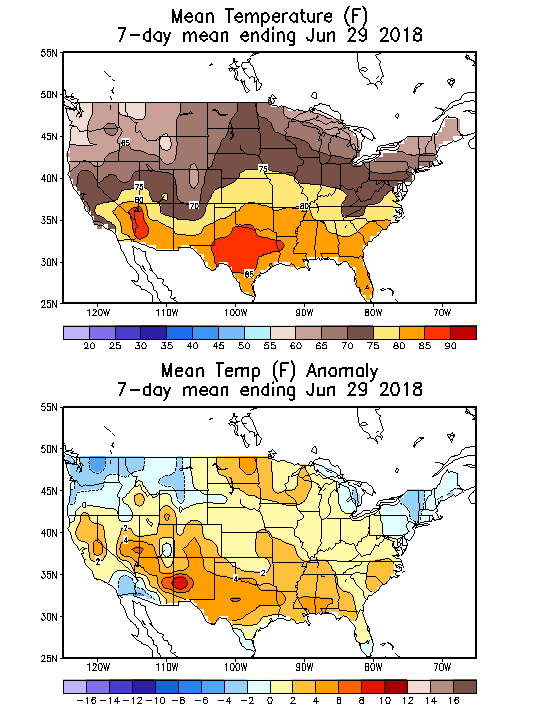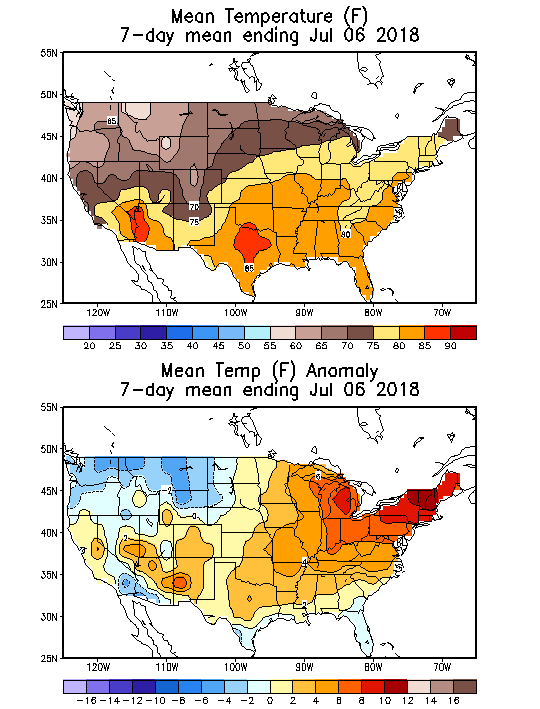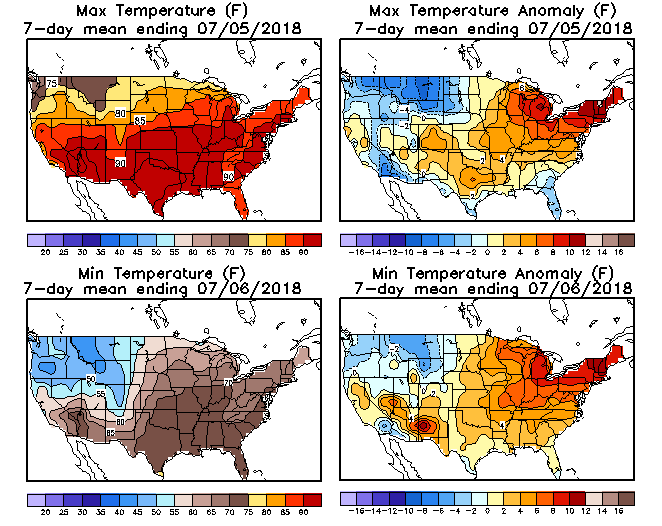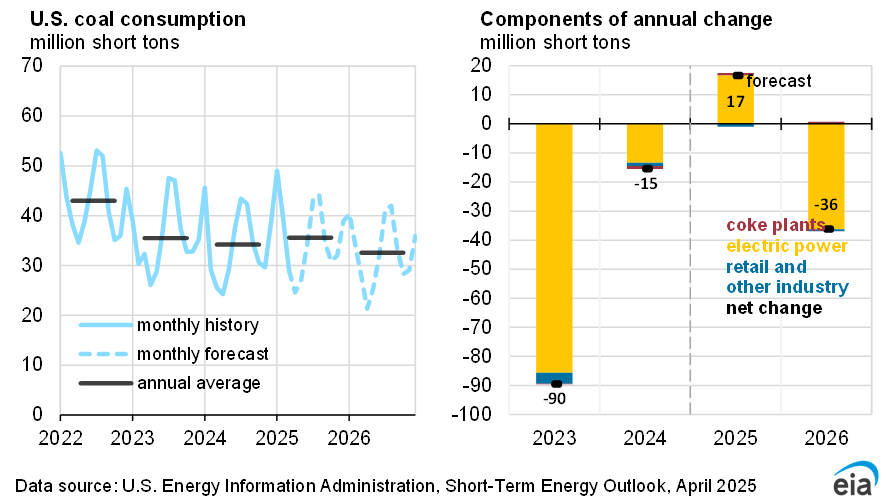
From: Natural Gas Intelligence
August Natural Gas Called Near Even as Production Still Weighing on Prices
August natural gas futures were set to open Tuesday slightly lower at around $2.826/MMBtu as production continues to temper any bullishness from recent and forecast heat.
EIA number +78 bcf. Slightly bearish as we went down a bit just after the release.
| Working gas in underground storage, Lower 48 states Summary textCSVJSN | |||||||||||||||||||||||||
|---|---|---|---|---|---|---|---|---|---|---|---|---|---|---|---|---|---|---|---|---|---|---|---|---|---|
| Historical Comparisons | |||||||||||||||||||||||||
| Stocks billion cubic feet (Bcf) | Year ago (06/29/17) | 5-year average (2013-17) | |||||||||||||||||||||||
| Region | 06/29/18 | 06/22/18 | net change | implied flow | Bcf | % change | Bcf | % change | |||||||||||||||||
| East | 460 | 430 | 30 | 30 | 560 | -17.9 | 569 | -19.2 | |||||||||||||||||
| Midwest | 455 | 425 | 30 | 30 | 696 | -34.6 | 614 | -25.9 | |||||||||||||||||
| Mountain | 139 | 133 | 6 | 6 | 187 | -25.7 | 163 | -14.7 | |||||||||||||||||
| Pacific | 257 | 251 | 6 | 6 | 286 | -10.1 | 302 | -14.9 | |||||||||||||||||
| South Central | 841 | 835 | 6 | 6 | 1,141 | -26.3 | 997 | -15.6 | |||||||||||||||||
| Salt | 245 | 252 | -7 | -7 | 333 | -26.4 | 288 | -14.9 | |||||||||||||||||
| Nonsalt | 596 | 583 | 13 | 13 | 808 | -26.2 | 710 | -16.1 | |||||||||||||||||
| Total | 2,152 | 2,074 | 78 | 78 | 2,869 | -25.0 | 2,645 | -18.6 | |||||||||||||||||
These were the temperatures that occurred during the 7 day period that was used for the last EIA report:

These temperatures below cover the period for this Thursday's EIA report:

Below, they are broken down into Highs/Lows for the same 7 day period:
Previous discussion:
By WxFollower - July 9, 2018, 2 p.m.
"I think that the market pays attention to it at certain times..........you must know that natural gas and grains will often trade long range outlooks/expectations."
---------------------------------------------------------------------------------------------------------------------------------------------
I agree with "At certain times" though I'm not so sure of "often trade long range". Based on my experience in following it on days when wx forecast changes are the dominant factor, it almost always weights the 2 week morning forecasts/models, especially when they have significant changes, much more heavily than longer range stuff due to the much better reliability. As mentioned, what I saw this morning was cooler mainly in week 1. Cooler in week 1 is obviously highly likely to mean less cooling needs because of the relatively high reliability as we know. Week 1 usually doesn't have significant changes but when it does the market often pays good attention. It also showed a little cooler in week 2. Cooler showing in week 3 on the latest CFS is much more highly speculative as we know. Just over the weekend, it showed hotter in the east as mentioned. Another thing to consider is that as unreliable as is week 3, week 4 is significantly less reliable than week 3. So, I don't even put weeks 3 and 4 in the same boat. That is like comparing weeks 2 and 3. We know week 2 is much less unreliable than week 3 just like week 1 is much more reliable than week 2.
We know that the 2 week long 12Z models sometimes have a significant impact, especially if the trends differ from those of the morning data.
Of course, there are days like this last Friday with price moves that can't be easily explained by wx forecast changes. As you know, though it often is, wx (forecasted demand) isn't always the dominant or even a signifcant factor on any one day. Sometimes changes in supply outlooks, EIA reports, technical factors (like support/resistance/overbought/oversold), other, or unknown factors can dominate on any one day. That must always be kept in mind or else trading results may suffer. Wx is far from everything as we know even though it is more often than not the single most important factor, especially outside of shoulder periods.
I mean no disrespect in these discussions. We don't always have the same perspective, which makes for interesting discussions. No matter what, civility is extremely important.
By WxFollower - July 9, 2018, 2:03 p.m.
"Where do you get your temps from?"
------------------------------------------------------
From here, Mike:
http://w2.weather.gov/climate/index.php?wfo=lot
By metmike - July 9, 2018, 3:40 p.m.
Larry,
I have never sensed any disrespect on your part when you are not in total agreement with me............never!
In fact, I welcome your very educated thoughts more when they disagree with me. We are all cursed with a bias from seeing things thru our own eyes and can never know everything.
Sometimes we can actually be smarter than the market about the upcoming weather. Let's say that 2 weeks from now was going to feature record cool temps and you saw the reason why but the models were not in agreement and the market traded the models.
Or, the market can often disregard some models, like an outlier/extreme GFS solution because it knows better........but, when you think about it, the market is always wrong(we hear that the market is always right but that only applies to the price at that moment)
If the market was always right, the price would never need to change. Each day, it gets closer to being right than the previous day by going higher or lower after dialing in the news that it didn't know the day before.
By metmike - July 9, 2018, 3:53 p.m.
Thanks for the link Larry!
Another item that you did not mention about extended forecasts that give them more power.
A change in a few days in the week 1 forecast, is equal to the change in those few days.
A change in the last few days of a week 2 forecast, is much more likely to have greater magnitude than that of the one in week 1 but it also represents the potential for an even greater change that carries thru into weeks 3 and beyond.
The speculative nature of the trading weather forecasts in this realm allows the period with less skill to be overweighted because of its much greater potential.
"Potential" is just another way to describe an aspect of speculating.
Last week's temperatures are known. We can still "speculate" on exactly how many CDD's were used but it will be in a fairly tight range.
This week's CDD's are not known with certainty but the range is much wider than last week's knowns.
Week 2 CDD's can be calculated from weather models but there is enough uncertainty for the range to be greater and changes, if they occur are much more likely to have greater magnitude than week 1 changes.
So less confidence and less weighting on a day vs day basis/comparison but sometimes offset by the greater magnitude and POTENTIALLY much greater magnitude when extrapolating out.
By WxFollower - July 9, 2018, 4:46 p.m.
You're welcome, Mike.
We agree about the greater magnitudes typically seen later vs earlier. For example, when a new GFS is released, the changes vs earlier runs are more often than not larger, say, late in week 2 vs early in week 2 or even early week 2 vs late week 1. So, late week 2 changes are quite often much greater than late week 1. As you said, the tradeoff is that the likelihood of those late week 2 changes being right is much lower than the likelihood of the late week 1 changes being right. So, the market has to weigh these factors out. I will say this. For late week 2, I think the market tends to weigh somewhat more the major ensemble means vs the operational GFS. Not always by any means, but I think there is a tendency because of the higher reliability of the ensemble means vs operational GFS late week 2....especially like for days 14-15 because by then the GFS often has big swings from run to run.
Hypothetical example: let's say a particular 12Z GFS run is cooler than a prior run in week 1 by a total of 6 CDDs. Now, let's say that same run is in contrast warmer than that same prior run in week 2 by a total of 11 CDDs. So, the total net change is warmer by 5 CDDs. Assuming the market reacts much to that 12Z GFS run, will it necessarily rise due to the net warming of 5 CDDs? Imo, not necessarily as it may weigh the higher reliability of the 6 CDD cooling more than the lower reliability of the later in the run 11 CDD warming. One thing the market may do is to accept the early 6 CDD cooling as a high probability to verify as well as to use that to suspect the model has a warm bias, especially in later periods. If so, it may decide to minimize the believability of the later 11 CDD warming due to warm bias. It may feel that the next runs won't have as much as or any of that later in the run 11 CDD warming. So, though it may rise due to the net 2 week warming of 5 CDDs, NG could still fall due to giving more weight to the cooler week 1. or perhaps it won't rise or fall. From my experience, how it weighs these disagreeing periods varies considerably from day to day. Sometimes known model biases come into play. Also, sometimes it doesn't react much at all to the 12Z GFS even with big changes. Or technical factors could come into play and muddy things up.
By metmike - July 9, 2018, 6:05 p.m.
I think that your example of the change in week 1 CDD's vs a greater change in week 2 CDD's was excellent as what often happens in the real world and what I was referring too.
I agree that the market is not going to consider them as equivalent week 1 CDD = week 2 CDD.
Every situation is different too and models never agree entirely either. Like you, I put almost all my weighting on ensemble solutions..........despite me showing individual models, like the operational GFS frequently.
One of the reasons that I do that is that it shows 4 easy to understand panels that display alot of information which the ensemble products don't show the same way.
Natural gas is testing the uptrend line from the Dec 2017 lows, just above 2.6, connecting to the higher lows in Feb. just below 2.7, then the higher lows in May at 2.727.
The best hope for ng is if the trend of the last Canadian ensemble mean solution of turning hotter again in week 2 gets traction.
| Natural gas 3 months |
Natural gas 1 year below
Natural gas 5 years below
| Natural gas 10 years below
|
Production Surge Keeping Natural Gas Futures Bears in Control; Spot Prices Pull Back
5:19 PM
Bears tightened their grip on the natural gas futures market Tuesday, sending prices lower as production continues to overshadow summer heat and storage deficits. Spot prices backed off Monday’s gains, including sharp declines in California and the Northeast coinciding with forecasts for less intense heat; the NGI National Spot Gas Average dropped 8 cents to $2.66/MMBtu
https://www.eia.gov/outlooks/steo/




Production Surge Keeping Natural Gas Futures Bears in Control; Spot Prices Pull Back
5:19 PM
From the very long article found at the above link, this little bit is the key to today's price drop:
"Looking at the weather, overnight changes heading into Tuesday’s session showed cooler trends late next week and next weekend, and those trends continued in the midday data, dropping a few additional cooling degree days (CDD), according to NatGasWeather."
I concur with this as I, myself, noted cooling models/forecasts. The forecast I saw had notable CDD losses in the 6-10 day period, which is consistent with the bolded. Days 11+ were near flat. So, I'm confident that a cooler 6-10 day period was the main wx influence today as that was dialed in leading to new selling.